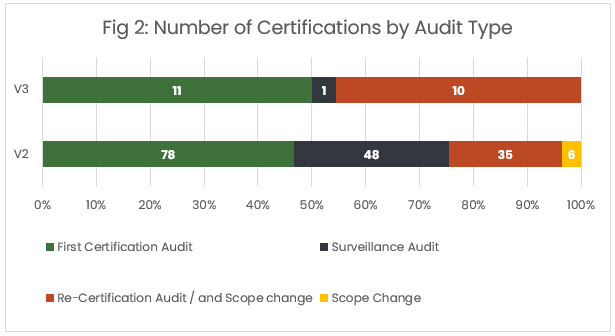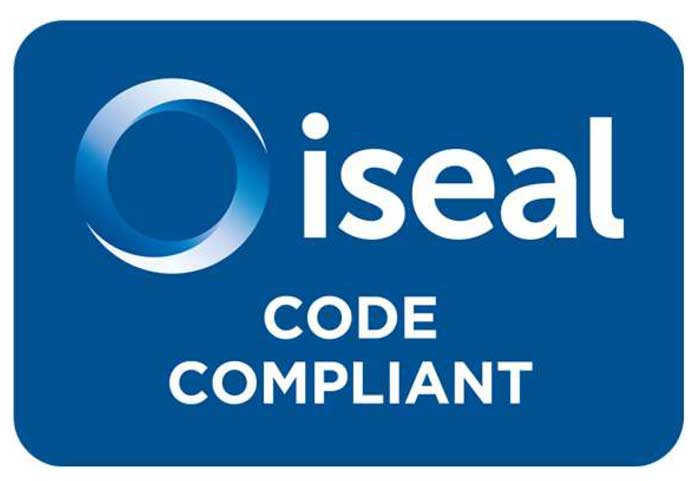D&R Insights: Non-Conformances increase with strengthened ASI Performance Standard V3
An analysis of Non-Conformance (NCs) data from current ASI Certifications for PS V2 and PS V3 between January 2020 and September 2023 shows that NCs have correspondingly increased under V3.
27 October 2023
In May 2022, the ASI Performance Standard (PS) V3 was published following an extensive multi-stakeholder standards revision process. The updated PS V3 Standard strengthens requirements across governance, environmental and social criteria relative to the PS V2 (2017) Standard.
An analysis of Non-Conformance (NCs) data from current ASI Certifications for PS V2 and PS V3 between January 2020 and September 2023 shows that NCs have correspondingly increased under V3. This underscores the intent of the ASI Standards Committee to set more challenging systems and performance requirements. A growth in NCs was anticipated and has been confirmed by the analysis. As more Entities seek certification under V3, further analysis and insights will be shared.
From a sectoral change perspective, increasing numbers of NCs means increasing numbers of ASI Members are on a continual improvement journey, in that they will work to close these gaps across successive audits and elevate their performance. Even more mature Entities that have been previously certified need to extend their sustainability efforts to improve their performance. Future ASI Standards revisions will also continue to move the goalposts forward, and in so doing, drive an ongoing evolution of the aluminium value chain.
Shift in relative frequency of Non-Conformances by ESG issue
The increase in frequency of NCs for PS V3 (22 Certificates, with 107 NCs) relative to PS V2 (167 Certificates, with 366 NCs identified) is shown in Figure 1 below. This has been driven by strengthening of requirements across governance, environmental and social criteria, particularly with regard to disclosure requirements.

Figure 1 shows the increase in frequency of NCs for PS V3 relative to PS V2.
Shift in relative frequency of Non-Conformances by Audit Type
ASI Audit Types can be grouped into First Certification, Surveillance, Re-Certification (with or without Scope Change), and stand-alone Scope Change Audits.
Figure 2 shows the distribution of Certifications by Audit Type for PS V2 and V3. PS V3 was published in May 2022 with a 1-year transition period when both V2 and V3 were open for Certification. For PS V3, all Audits in the period analysed were a First Certification or Re-Certification, with only one Surveillance Audit. For the data period, there is a higher proportion of Re-Certification Audits for PS V3 than V2, as existing V2 Certifications needed to roll onto V3 when the previous Certification Period ended.

Figure 2 shows the distribution of Certifications by Audit Type for PS V2 and V3. PS V3 was published in May 2022 with a 1-year transition period when both V2 and V3 were open for Certification.
Figure 3 shows the change in relative frequency of NCs by Audit Type. As anticipated, during Re-Certification Audits, Entities that transitioned from PS V2 to V3 saw an increase in the number of NCs to nearly 5 NCs per Certificate, while those Entities which continued their Certification with PS V2 recorded on average only 1 NC per Certificate. This highlights that even for previously Certified Entities, the updated Performance Standard (V3) is more challenging and drives further performance improvements.

Figure 3 shows the change in relative frequency of NCs by Audit Type.
In conclusion: ASI Performance Standard V3 raises expectations for improvement in the aluminium value chain.
This first analysis of Non-Conformance data for ASI Performance Standard V2 and V3 highlights the changing landscape of compliance and performance expectations of ASI Certified Entities. As expected, audits conducted for the Performance Standard V3 resulted in a higher number of NCs.
Regular updates to the ASI Standards will continue to set new performance expectations through multi-stakeholder consultation, while audits are identifying improvement areas on the ground. Together, these efforts are working to drive positive change in the sector. With this in mind, ASI Members are encouraged to focus on identifying and closing conformance gaps to meet the enhanced requirements of PS V3.
SHARE THIS ARTICLE



